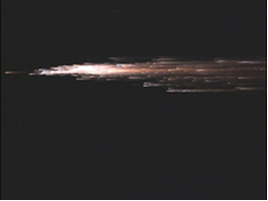Satellites re-entries
No satellites are visible during daylight (other than flashes from Iridium satellites under rarefied circumstances) but if a satellite orbit decays it comes closer and closer to earth and eventually re-enters the atmosphere. This can be seen day or night.
Like meteors, satellite re-entries burn up due to friction as they enter the gaseous envelope. Since they are a relatively large size and also have some heat-resistant parts this burn-up is longer lasting and more spectacular. Various colours are possible due to the different elements in the make-up of the satellite. A vivid light display, often like a train of lights or a railway carriage, is produced. The telltale signs for the meteor are all relevant to satellite re-entries except that duration can last up to two or three minutes, giving the appearance of a slow moving, possibly burning, aircraft which is crossing the sky.
In July 1979 one of the most famous of all satellites, the American Skylab, re-entered our atmosphere. Since it was so large and scientists had little control over its descent there were great fears that it would not burn up completely. Those out to make a quick-sell persuaded some people to buy tin hats to protect them from Skylab’s fall. They would, of course, have been totally useless had, by some remote chance, a piece of the satellite fallen on someone’s head. As it was, Skylab crashed into the Australian desert – or at least the few parts of it which survived the burn-up did. People all over Western Australia were treated to the amazing sight as it came down, and some good film was taken – illustrating just how odd these re-entries can look.
————
Case 24 December 2011. Another fine illustration came from North Europe, with the re-entry of the last stage of the Soyuz rocket that brought Dutch astronaut Andre Kuipers up to the ISS. It was observed by many people as it occurred around 5:30 pm. Some spectacular videos were acquired and made available through the social networks: (http://www.youtube.com/watch?v=N4JRiHP1YVU&feature=player_embedded)
Telltale signs: Observations at numerous locations over a very wide area, describing a cigar/disc with luminous windows (otherwise a trail of glowing objects) emitting a trail, traversing slowly along a level or curving path. Duration can be up to 3 minutes.
Resources:
Center for Orbital and Reentry Debris Studies (Listing per date of past, recent and upcoming reentries, and supporting detailed information per event, e.g. location of object at predicted reentry time):
http://www.aerospace.org/cords/reentry-predictions/upcoming-reentries/
